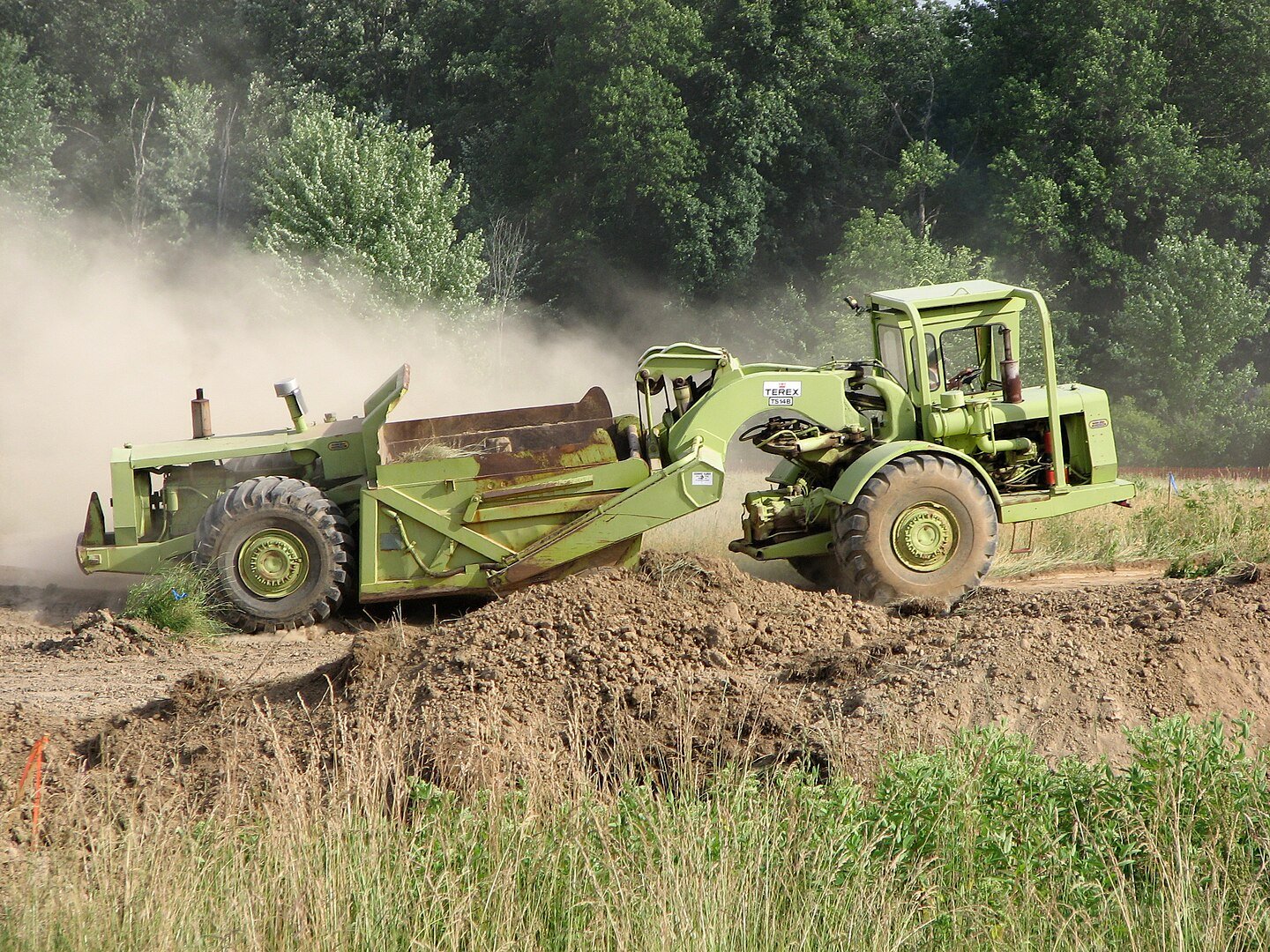
A Brief History of Scrapers
Scrapers have played a vital role in earthmoving for over a century, evolving from simple animal-drawn tools into powerful, self-propelled machines. The earliest notable design was the Fresno Scraper, developed in the 1880s, which revolutionized grading and excavation by allowing operators to cut and transport soil short distances. In the early 20th century, the shift to tractor-towed scrapers marked the beginning of mechanized earthmoving. Innovators like LeTourneau and Caterpillar introduced cable-operated and hydraulic systems in the 1930s and ’40s, improving efficiency and productivity, especially during World War II when demand surged for military infrastructure. Therefore, Scrapers date back to the early 20th century when horse-drawn models were used before the introduction of motorized versions in the 1930s.
The post-war boom of the 1950s–1970s saw the introduction of self-propelled scrapers, such as the Caterpillar 621 and 631, which combined loading, hauling, and dumping into a single unit. These machines became essential for large-scale highway and civil works projects. During the 1980s and 1990s, scraper technology matured with a focus on hydraulic refinement, operator comfort, and the rise of elevating and push-pull scrapers. However, in many regions, their use declined slightly due to the increasing flexibility of excavator–ADT (articulated dump truck) combinations.
Today, scrapers remain indispensable in specific applications—especially mass grading, mining, and large-scale earthmoving—with manufacturers like Caterpillar, K-Tec, and Ashland Industries offering advanced, high-capacity models equipped with GPS, telematics, and fuel-efficient systems.
Types of Scrapers
Scrapers are earthmoving machines used primarily for cutting, lifting, and transporting soil over short to medium distances, commonly in large-scale construction, mining, and agriculture. They’re especially useful in leveling and grading work. Here are the main types of scrapers:
Motor (Self-Propelled) Scrapers

Motor scrapers are heavy-duty machines that combine a tractor unit and a scraper bowl into a single self-propelled vehicle. Unlike towed scrapers, they do not require an external power source like a bulldozer or tractor to operate; in other words, these scrapers have their own engine and can operate independently without being towed.
These powered machines can cut, load, haul, dump materials and discharge material autonomously without the need for a towing vehicle, making them highly versatile and efficient for bulk earthmoving. Most efficient for medium to long haul distances.
- Key Characteristics:
- Self-contained propulsion – Equipped with one or two engines (single or twin-engine models).
- High travel speeds – Faster than many other earthmovers, especially on flat ground.
- Hydraulic or mechanical bowl controls – For precise cutting and dumping.
- Large capacity – Typically ranging from 15 to 45 cubic yards.
- Tires and suspension – Designed for rough terrain but optimized for graded surfaces.
- Push-loading capable – Can be assisted by a bulldozer when working with dense or heavy materials.
- Key Characteristics:
- Highway and road construction – Grading and leveling long corridors.
- Large-scale earthmoving – Moving large volumes of soil or aggregate quickly on expansive job sites.
- Mining and quarrying – Especially in surface mining operations where material needs to be relocated over moderate distances.
- Airport and industrial site prep – Where extensive leveling and material distribution is needed.
Towed (Pull-Type) Scrapers
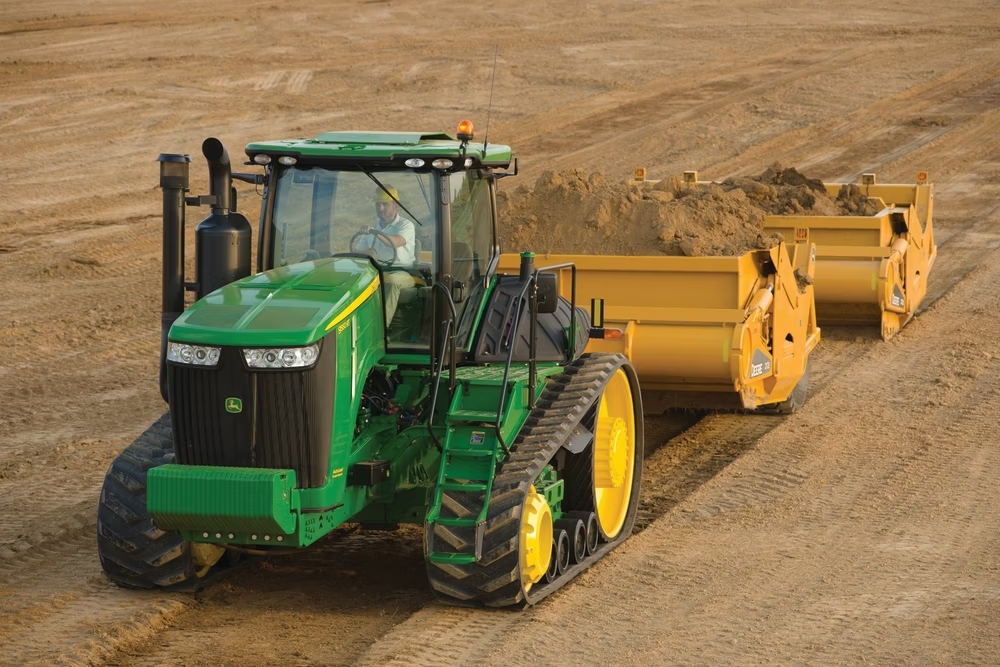
Towed scrapers are non-motorized earthmoving implements that must be pulled by an external power unit, typically a tractor, articulated dump truck, or bulldozer. They consist of a scraper bowl with cutting edges for loading material and are widely used in agriculture, construction, lighter construction applications and land development where flexibility and cost-efficiency are key. Thus, common in agriculture and for smaller earthmoving tasks.
- Key Characteristics:
- Requires external prime mover – Power provided by a tractor or dozer.
- Lower capital cost – More affordable than self-propelled units.
- Interchangeable power source – One tractor can operate multiple scraper units (if staggered).
- Versatile sizes – Bowl capacities range from 3 to 20+ cubic yards, depending on model and tractor pairing.
- Simple design – Fewer moving parts, easier maintenance.
- Hydraulic controls – Operated via the tractor’s hydraulic system for raising/lowering the bowl and apron.
- Typical Applications:
- Agricultural land leveling – For precision field grading and water drainage optimization.
- Small to mid-scale earthmoving projects – Residential site prep, landscaping, sports fields.
- Low-volume cut-and-fill jobs – Ideal for tasks not requiring long hauls or high production rates.
- Remote or soft-soil areas – Where maneuverability and reduced ground pressure are important.
Elevating Scrapers
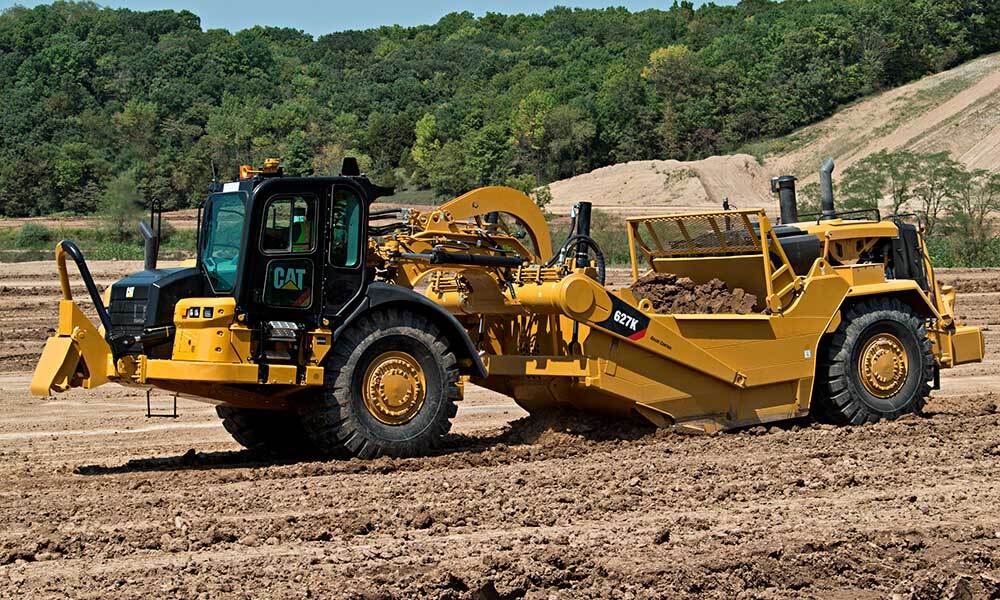
Elevating scrapers are a type of self-propelled scraper equipped with a powered elevator mechanism (a conveyor system with rotating flights or paddles) that lifts material into the bowl during loading. Unlike traditional open-bowl scrapers that rely on push dozers or gravity, elevating scrapers are capable of self-loading, since they use a conveyor to load material automatically into the bowl, making them well-suited for operations where independence and speed are priorities. This allows faster loading, especially in cohesive soils, without needing a push tractor. Ideal for light to medium material and finish grading.
- Key Characteristics:
- Self-loading capability – The elevator lifts soil from the cutting edge directly into the bowl.
- Efficient in cohesive soils – Ideal for medium to light clay or loamy material.
- Precise control – Excellent for fine grading and contour work thanks to consistent material spread.
- Smaller bowl size – Typically 8–20 cubic yards, optimized for lighter loads and high maneuverability.
- Single-engine, rubber-tired – Compact and agile for confined sites.
- Reduced need for support equipment – Eliminates the need for push tractors, lowering operating costs.
- Typical Applications:
- Road building and maintenance – Especially for shoulders and subgrades where precision matters.
- Airfield construction – Used for fine contouring of runways and taxiways.
- Site prep and subdivision development – Where frequent short hauls and accurate cuts are essential.
- Land leveling in agriculture – Especially where minimal compaction and precision are required.
- Stockpile management – Efficient at loading loose material from storage areas or stockpiles.
Open Bowl Scrapers
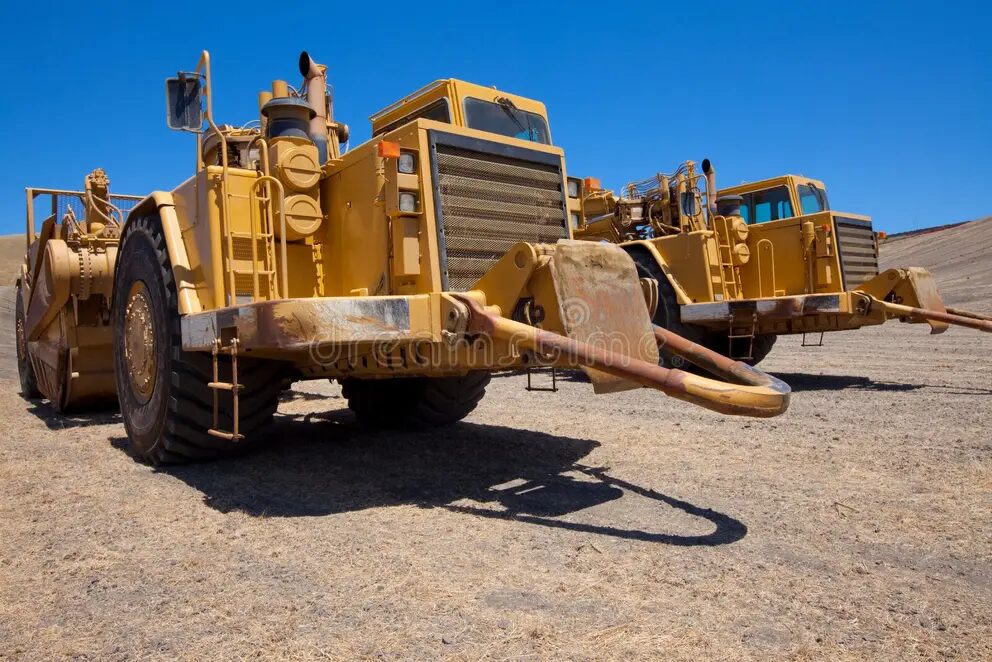
Open bowl scrapers are one of the most traditional and widely used types of self-propelled scrapers in heavy construction and mining operations. They consist of a large, open-front bowl mounted between the front power unit and the rear axle. These machines are specifically designed to cut, collect, haul, and discharge soil or aggregate over medium distances. What sets the open bowl scraper apart is its simple, open loading design, where material is cut and guided into the bowl by a cutting edge located beneath the front of the scraper. Loading is typically assisted by a push tractor in heavier or more cohesive soils. The machine relies on gravity and the rolling action of the front apron to fill the bowl.
Because of their high capacity and relatively fast cycle times, open bowl scrapers are commonly used on large-scale earthmoving projects, especially where the material is dry, loose, or easily workable. Preferred for bulk earthmoving with harder or compacted soils.
- Key Characteristics:
- Open loading system – No elevator or conveyor, material enters the bowl directly via the cutting edge.
- Large bowl capacity – Typically ranges from 20 to 45 cubic yards, depending on model and configuration.
- Requires external push support in tough soils – Especially in sticky clays or when working on inclines.
- Hydraulically operated apron and ejector – Allows precise control during material loading and unloading.
- Efficient on level or gently sloped terrain – Designed for hauling across prepared haul roads and open spaces.
- Simpler mechanics – Fewer moving parts compared to elevating scrapers, which can result in easier maintenance.
- Key Characteristics:
- Highway and freeway construction – Ideal for cut-and-fill operations over long distances.
- Mass excavation and site development – Frequently used in dam, airport, and industrial park projects.
- Surface mining and overburden removal – Suitable for moving large quantities of material efficiently.
- Agricultural land shaping (large-scale) – When combined with push tractors, they can be effective for shaping large tracts of farmland.
- Earthworks in infrastructure megaprojects – Especially effective where project scale justifies large-capacity, high-output machines.
Auger Scrapers
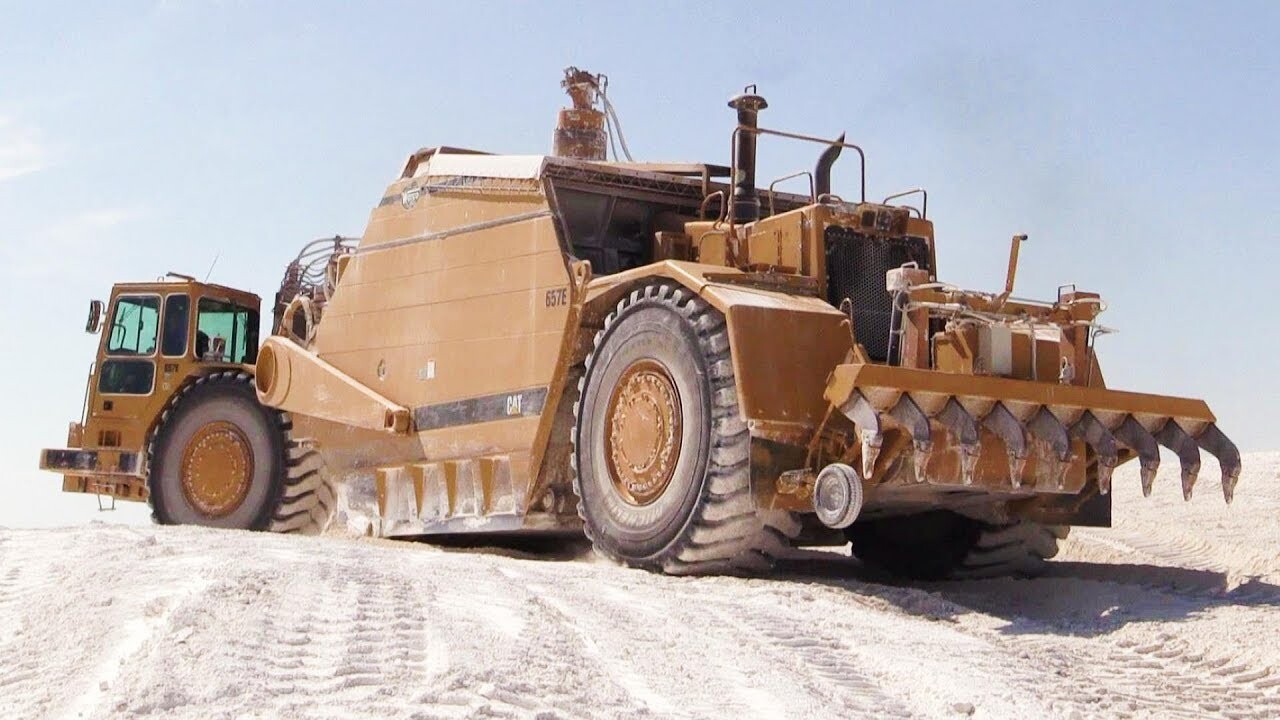
Auger scrapers are specialized earthmoving machines engineered to efficiently handle heavy, wet, or cohesive soils—conditions that typically hinder conventional scrapers. Unlike standard bowl scrapers that rely on gravity and blade action, auger scrapers feature a hydraulically powered horizontal auger inside the bowl. This auger actively feeds material inward and upward, enabling faster, more consistent loading cycles, even in sticky or saturated ground. As self-loading units, they eliminate the need for push tractors, reducing manpower and equipment costs—particularly valuable on remote or soft-ground sites.
Auger scrapers offer superior fill quality, fuel efficiency, and adaptability to varying soil textures, often enhanced by modern features such as GPS-assisted controls and ergonomic operator stations. Though their powered systems introduce additional maintenance demands, the productivity and operational gains make them a high-value choice in agriculture, infrastructure development, and land reclamation projects.
- Key Characteristics:
- Self-loading capability – Eliminates the need for a push dozer.
- Powered auger feed – Ensures fast, uniform loading in cohesive soils.
- Consistent fill and compaction – Improves efficiency and reduces passes.
- Hydraulic drive systems – Offer control and adaptability to varied materials.
- Available in various capacities – Ranging from ~14 to 34 cubic yards.
- Typical Applications:
- Agriculture – Land leveling, irrigation prep, and drainage in sticky soils.
- Construction – Site grading where standard scrapers would clog or stall.
- Reclamation – Effective in redistributing topsoil and overburden.
- Infrastructure – Used in wet or clay-heavy zones during roadbed prep.
Fresno Scraper
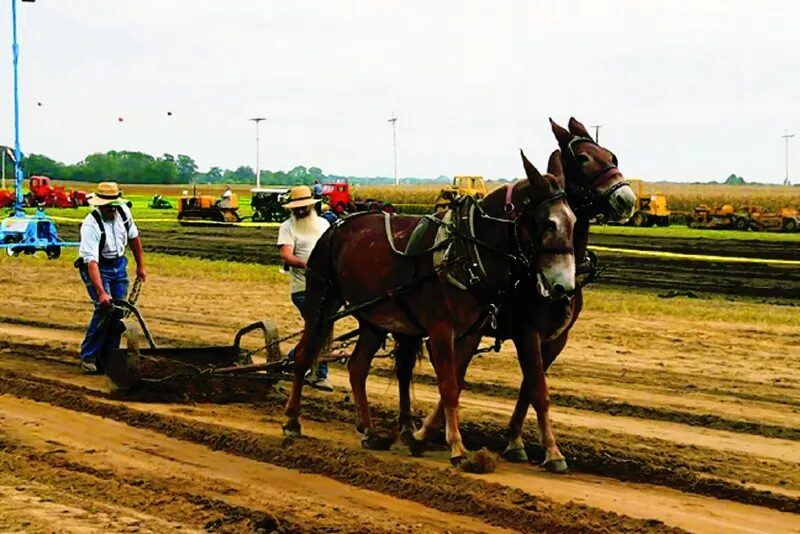
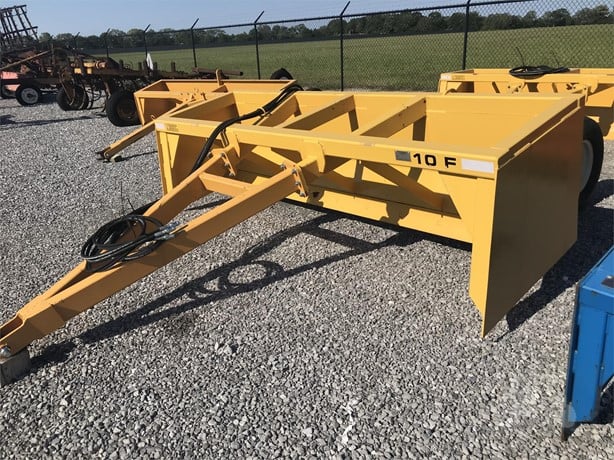
The Fresno scraper is a historical yet foundational earthmoving implement that played a critical role in shaping early construction, agriculture, and civil engineering practices. Developed in the late 19th century in California’s San Joaquin Valley, near the city of Fresno, it became one of the first practical solutions for large-scale soil movement and land leveling. The invention is credited to James Porteous, who refined earlier designs into a more durable and maneuverable machine suited for the demands of irrigation and railroad projects in the American West.
The scraper consists of a curved metal bowl or scoop mounted between two large wheels, with a handle or hitch for animal or mechanical draft. The blade scrapes the soil as the implement is pulled forward, collecting it in the bowl. The operator could then tilt or lift the scoop to dump the material where needed. This ability to load, carry, and dump soil in a controlled manner was revolutionary at the time and formed the basis for later self-propelled scrapers.
- Key Characteristics:
- Manual or horse-drawn – Originally operated by teams of horses or mules; later adapted for tractors.
- Curved steel bowl – Designed to cut, gather, and carry soil efficiently.
- Adjustable angle – Simple lever mechanisms allowed operators to control the depth of cut and dumping.
- Low cost and simplicity – Easily maintained and operated, making it accessible for widespread agricultural use.
- Typical Applications:
-
Irrigation and Agricultural Land Development – Widely used in the early 20th century to level farmland for flood irrigation, especially in arid regions like California’s Central Valley.
-
Road and Railway Construction – Played a key role in early infrastructure projects, preparing roadbeds and leveling terrain for expanding transportation networks.
-
Canal and Ditch Excavation – Ideal for shallow trenching and shaping irrigation canals, drainage ditches, and small water management systems.
-
Land Grading and Homestead Development – Used by settlers and farmers for shaping plots, clearing fields, and preparing land for buildings or cultivation.
-
Wheel tractor-scrapers (belly scrapers)

Wheel tractor-scrapers, also known as belly scrapers, are self-propelled earthmoving machines designed to cut, load, haul, and discharge soil in a single cycle. They consist of a front tractor unit and a rear scraper bowl positioned between the wheels. As the machine advances, the bowl’s cutting edge slices into the ground, collecting material that is then transported and dumped at a designated location.
These machines are highly efficient for medium-distance hauls (300–3,000 meters) and are commonly used in road building, mass excavation, mining, and large-scale site development. Scrapers may be self-loading (elevating) or require a push dozer (open bowl), with some models featuring tandem loading or push-pull capability. Fast, versatile, and ideal for balanced cut-and-fill operations on flat to moderately undulating terrain, they remain a staple in modern earthmoving fleets.
- Key Characteristics:
- Integrated loading and hauling – Combines excavation, transport, and discharge functions in one machine.
- Scraper bowl – Mounted between the front and rear axles, equipped with a cutting edge and adjustable apron for material control.
- Single or tandem-engine configurations – Single-engine units are common, but dual-engine models provide greater power and traction.
- Elevating or open bowl options – Elevating scrapers use a conveyor for self-loading; open bowl scrapers often require push assistance.
- High travel speed – Designed for fast cycle times on medium-length hauls.
- Push-pull systems – Some scrapers can latch onto one another for efficient tandem loading, increasing productivity.
- Typical Applications:
- Highway and road construction – Efficient for building roadbeds, embankments, and grading over long, linear corridors.
- Mass excavation and site preparation – Ideal for large-scale cut-and-fill operations, including housing developments, airports, and industrial zones.
- Mining and overburden removal – Used in surface mining to remove or redistribute non-load-bearing material.
- Land reclamation and agricultural development – Useful in reshaping landscapes, filling depressions, and grading large tracts of farmland or reclaimed land.
- Dam and canal construction – Efficient for moving large amounts of soil in flat, expansive job sites with consistent soil conditions
Main Models & Manufacturers
Here are some famous and widely recognized scraper models across major manufacturers, known for their performance in heavy-duty earthmoving operations:
- Caterpillar 657G
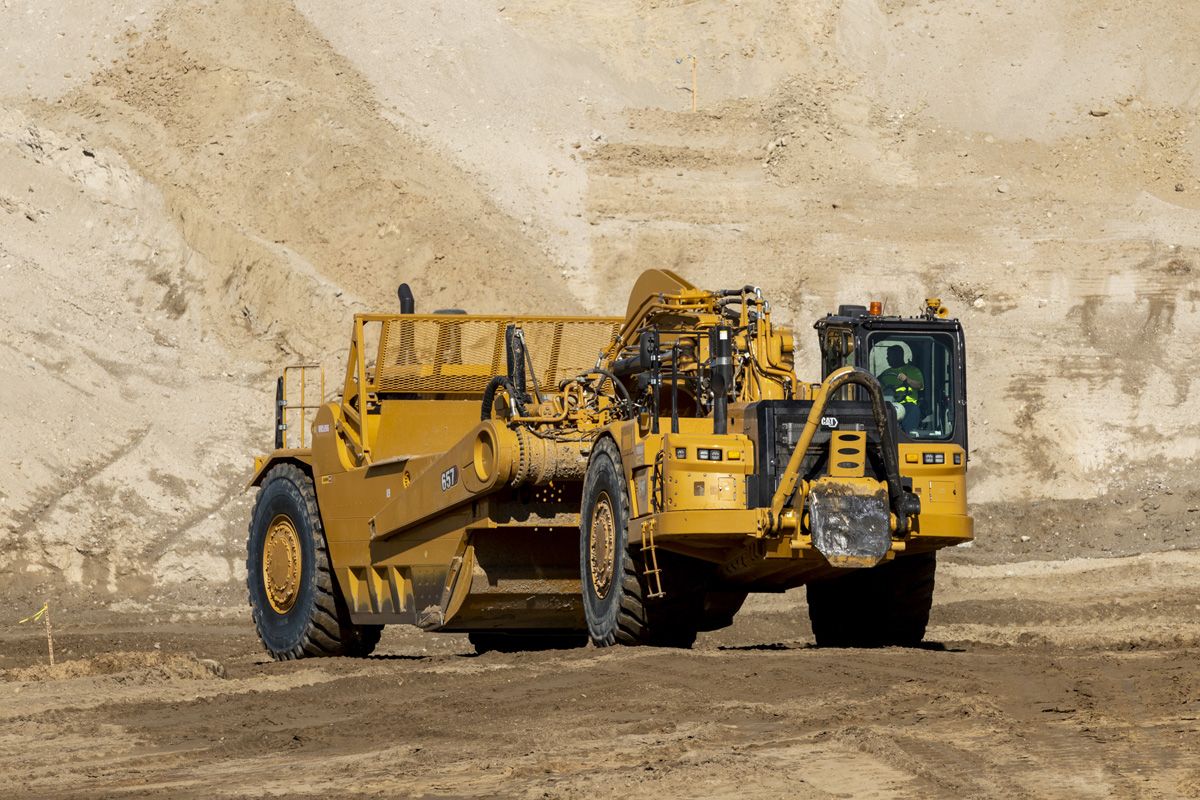
- John Deere 1812DC
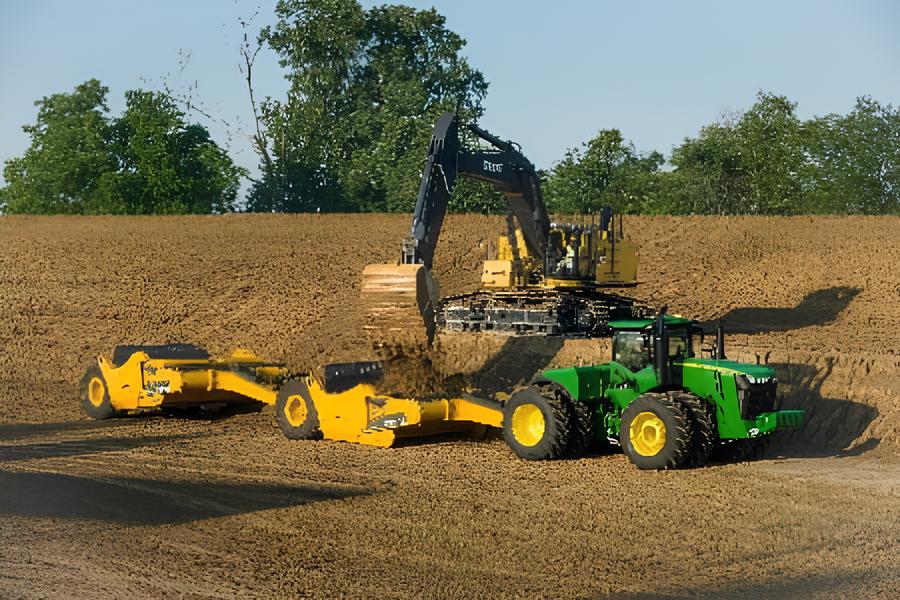
- K-Tec 1233

Main Uses of Scrapers
Scrapers are specialized earthmoving machines designed to cut, collect, transport, and discharge soil in one continuous cycle. Their key strength lies in efficiently handling large volumes of material over medium distances, especially in balanced cut-and-fill operations.
-
- Mass Earthmoving – Ideal for large-scale projects like highways, airports, and site developments where material needs to be moved from cuts to fills efficiently.
- Road and Railway Construction – Used to establish subgrades and embankments by continuously removing and redistributing soil.
- Site Preparation and Land Grading – Effective for leveling large areas, particularly in agriculture, housing developments, and industrial sites.
- Mining and Overburden Removal – Scrapers, especially larger twin-engine models, are used to strip surface layers in open-pit mining or reclamation zones.
- Land Reclamation and Drainage Projects – Frequently used to shape terrain, level fields, and create or fill water retention systems.
In Summary
Scrapers are high-productivity earthmoving machines designed for cutting, collecting, transporting, and dumping soil over relatively long distances. Their history dates back to the early days of mechanized construction and they’ve evolved into powerful, specialized tools for major civil engineering and mining projects. Available in multiple types – towed, self-propelled, elevating, and push-pull – scrapers are best suited for large-scale, high-volume grading and hauling operations. While not as versatile as excavators in tight or varied terrain, they remain unmatched in fast, bulk earthmoving on large open sites.


 Copyright 2017-2025 All rights reserved.
Copyright 2017-2025 All rights reserved.